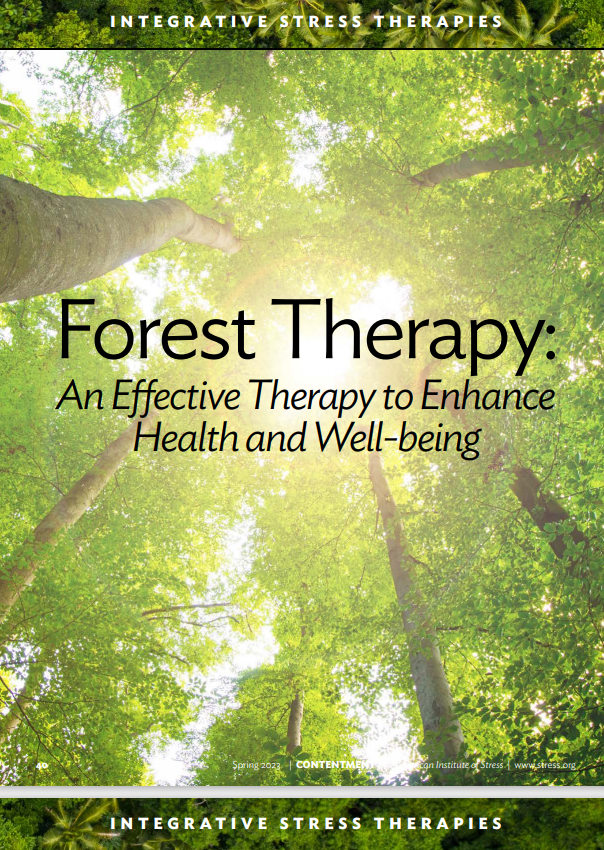
*This is an article from the Spring 2023 issue of Contentment Magazine.
By Stephanie Ross PhD, MHD, HT, CNC, FAIS
In the United States, prevalence of psychological stress proliferates unabatedly and in epidemic proportions. Recent studies have shown that stress levels among Americans are higher than the overall world average. Without a doubt, Americans are stressed about the future of the nation, money, work, the political climate, violence and crime.1 Current research suggests there is a direct connection between our increasingly stressed-out nation and the decrease in U.S. life expectancy. A 2017 report indicates that life expectancy was the lowest it had been in a decade and is linked to an increase in what researchers refer to as “deaths of despair” — opioid overdose, alcohol-related liver cirrhosis and suicide.1
Although stress can be an unpleasant experience, it is a normal part of life. Our capacity to deal with life’s stressors in an effective manner ultimately determines how it impacts us, both positive or negative, on every level – mind, body and spirit. For this reason, exploring the natural elements that humankind evolved with, and embracing these gifts of nature which surround us, has the potential to help restore our intrinsic peace and calm in a much troubled world.
Forest Therapy
Forest therapy evolved from the Japanese practice of shinrin-yoku, or “forest bathing,” and involves conducting forest-based treatment activities to improve one’s health in a forest environment. Shinrin-yoku originated in Japan in the 1980’s in response to a national spike in stress-related illness that was attributed to people spending excessive amounts of time working in technology and industrial settings. In response, certified trails were created to guide people in outdoor experiences. After decades of research, the practice of Shinrin-yoku continues to show its effectiveness in helping to reduce stress, improve attention, boost immunity, and uplift mood.
Defining Forest Therapy
Forest therapy differs from a guided nature walk that focuses on identifying trees or birds, but rather relies on trained forest guides, who utilize a slow pace to engage people to experience the pleasures of nature through all of their senses. The practice of forest therapy encourages people to be present in the body or in the moment, enjoying the sensation of being alive and deriving profound benefits from the connection between ourselves and the surrounding natural world.

Studies have shown that forest therapy increases immunity and improves one’s health by utilizing various elements of nature, such as fragrance and landscape.2,3 The primary elements of forest therapy are walking, experiencing the forest with the five senses (seeing, hearing, touching, smelling, and tasting), forest meditation, Qi-Gong, aromatherapy, herbal tea therapy, and making crafts using natural materials.4 Forest activities focus mainly on walking in the forest, yoga, appreciating the natural elements, breathing or walking meditation, and experiencing the aromatic scents that characterize the forest environment.
Benefits of Forest Therapy
Forest therapy involves not only the healing factor of the forest environment but also the positive experiences derived from the natural scenery and the enhanced attitudes towards nature. Research confirms that the forest environment not only brings changes to one’s physiological indicators — such as heartbeat, muscle tone, blood pressure (BP), heart rate variability (HRV),5-7 cortisol levels,8 pain relief,9 respiratory function,10 but also improves one’s mental state. Psychologically, the forest landscape has positive effects on stress and anxiety,11 depression,12 quality of life (QOL),13 mood,14 emotional burnout;15 and cognitively, on concentration16 and cognitive function improvement.17
Author Summary
Forest therapy provides a natural, effective approach to reduce stress, elevate mood, and improve over-all well-being. It incorporates various natural healing elements that include sunlight, volatile essential oils, water, earth and rock, woody and green landscapes, sound, temperature and humidity.18 Spending at least 20 minutes a day in nature has been shown to enhance health and well-being. By embracing our relationship with nature, humans have an opportunity to connect with our source and healing potential, and to live a life of purpose and fullness.
References
- American Psychological Association. Stress in America: The State of Our Nation. Stress in America Survey. 2017
- Li Q. (Ed.) What is Forest Medicine? In Forest Medicine; Nova Science Publisher: New York, NY, USA, 2013; pp. 3–10.
- Kim BJ, Jeong H, Park S, Lee S. Forest adjuvant anti-cancer therapy to enhance natural cytotoxicity in urban women with breast cancer: A preliminary prospective interventional study. J. Integr. Med. 2015; 7:474–478.
- Lee I, Choi H, Bang K, Kim S, Song M, Lee B. Effects of forest therapy on depressive symptoms among adults: A systematic review. J. Environ. Res. Public Health. 2017;14: 321–339.
- Niedermeier M, Grafetstätter C, Hartl A, Kopp M. A randomized crossover trial on acute stress-related physiological responses to mountain hiking. J. Environ. Res. Public Health 2017; 14:905.
- Wu Q, Ye B, Lv X, Mao G, Wang S, Chen Z, Wang G. Adjunctive therapeutic effects of Cinnamomum camphora forest environment on elderly patients with hypertension. J. Gerontol. 2020; 14:327–331.
- Mao GX, Cao YB, Lan XG, He, et al. Therapeutic effect of forest bathing on human hypertension in the elderly. Cardiol. 2012; 60:495–502.
- Jia BB, Yang ZX, Mao GX, Lyu YD, et al. Health effect of forest bathing trip on elderly patients with chronic obstructive pulmonary disease. Environ. Sci. 2016; 29:212–218.
- Kang B, Kim T, Kim MJ, et al. Relief of chronic posterior neck pain depending on the type of forest therapy: Comparison of the therapeutic effect of forest bathing alone versus forest bathing with exercise. Rehabil. Med. 2015; 9:57.
- Janik H, Kraft K, Trabandt A. Efficacy of healing forest therapy for patients with chronic obstructive pulmonary disease (COPD). J. Integr. Med. 2021; 48:23.
- Lee, JY, Lee DC. Cardiac and pulmonary benefits of forest walking versus city walking in elderly women: A randomised, controlled, open-label trial. J. Integr. Med. 2014; 6:5–11.
- Bang KS, Lee IS, Kim SJ, Song MK, Park SE. The effects of urban forest-walking program on health promotion behavior, physical health, depression, and quality of life: A randomized controlled trial of office-workers. Korean Acad. Nurs. 2016; 46:140–148.
- Brown DK, Barton J, Pretty J, Gladwell VF. Walks4Work: Assessing the role of the natural environment in a workplace physical activity intervention. J. Work Environ. Health 2014;40:390–399.
- Wu, Q.; Ye, B.; Lv, X.; Mao, G.; Wang, S.; Chen, Z.; Wang, G. Adjunctive therapeutic effects of Cinnamomum camphora forest environment on elderly patients with hypertension. J. Gerontol. 2020;14:327–331.
- Mao GX, Lan XG, Cao YB, Chen ZM, et al. Effects of short-term forest bathing on human health in a broad-leaved evergreen forest in Zhejiang Province, China. Environ. Sci. 2012; 25:317–324.
- Sonntag-Öström E, Nordin M, Lundell Y, et al. Restorative effects of visits to urban and forest environments in patients with exhaustion disorder. Urban For. Urban Green. 2014; 13: 344–354.
- Shin WS, Shin CS, Yeoun PS, Kim JJ. The influence of interaction with forest on cognitive function. J. For. Res. 2011;26:595–598.
- Park KJ, Shin CS, Kim D. Interpretation of the forest therapy process and effect verification through keyword analysis of literature on forest therapy. Korean Soc. For. Sci. 2021; 110:82–90.
ABOUT THE AUTHOR

Dr. Stephanie Ross is an internationally recognized leader in Integrative Health. She served as clinical professor and the founding Director of the Department of Complementary and Integrative Health at Drexel University, College of Nursing and Health Professions, a pioneering program that partnered with the Andrew Weil Center for Integrative Medicine. Prior to Drexel, she initiated the first course in phytomedicine at Temple University School of Medicine, where she taught medical students. In addition to her scholarly achievements, Dr. Ross is a skilled and dedicated Integrative Health Practitioner, who guides her patients in achieving optimal health and wellness, with emphasis on integrative stress solutions. Dr. Ross has garnered numerous awards, is listed in Who’s Who in Health Sciences, and is a Fellow of the American Institute of Stress where she serves on the Executive Advisory Board and as Editor of Contentment, their peer-reviewed international publication.
Ross is extensively published with more than 97 articles featured in international peer-reviewed journals that are cited in the National Institute of Health’s Library of Medicine (PubMed). Dr. Ross serves as the Associate Editor for the peer-reviewed international Holistic Nursing Practice journal. She is a sought after consultant on Workplace Stress and a keynote speaker at Corporations and Healthcare Systems.
Dr. Ross offers telehealth and on-site consultations. She works primarily with patients who are referred by healthcare providers, providing a supportive interprofessional healthcare team approach to maximize health and well-being.
Office hours by appointment. Tel. 215-341-5846
Contentment Magazine
The dictionary defines “content” as being in a state of peaceful happiness. The AIS magazine is called Contentment because we want all of our guests and members to find contentment in their lives by learning about stress management and finding what works best for each them. Stress is unavoidable, and comes in many shapes and sizes that makes being in a state of peaceful happiness seem like a very lofty goal. But happiness is easy to find once you are able to find ways to manage your stress and keep a healthy perspective when going though difficult times in life. You will always have stress, but stress does not always have you!

Leave A Comment
You must be logged in to post a comment.